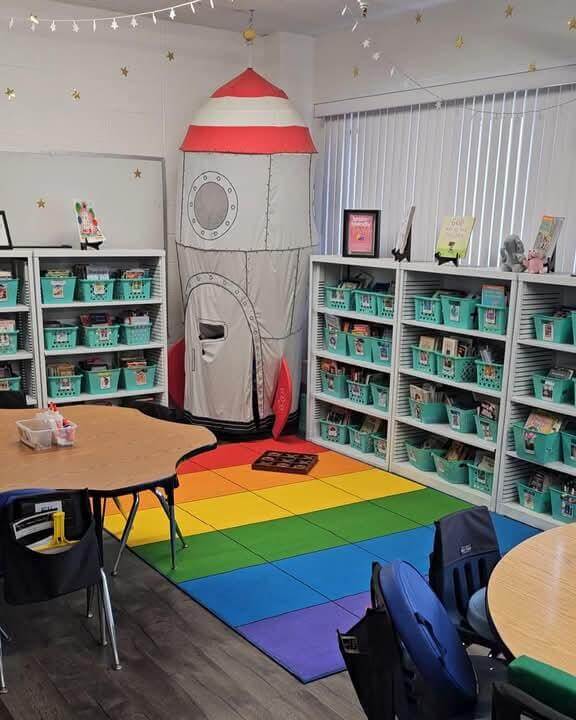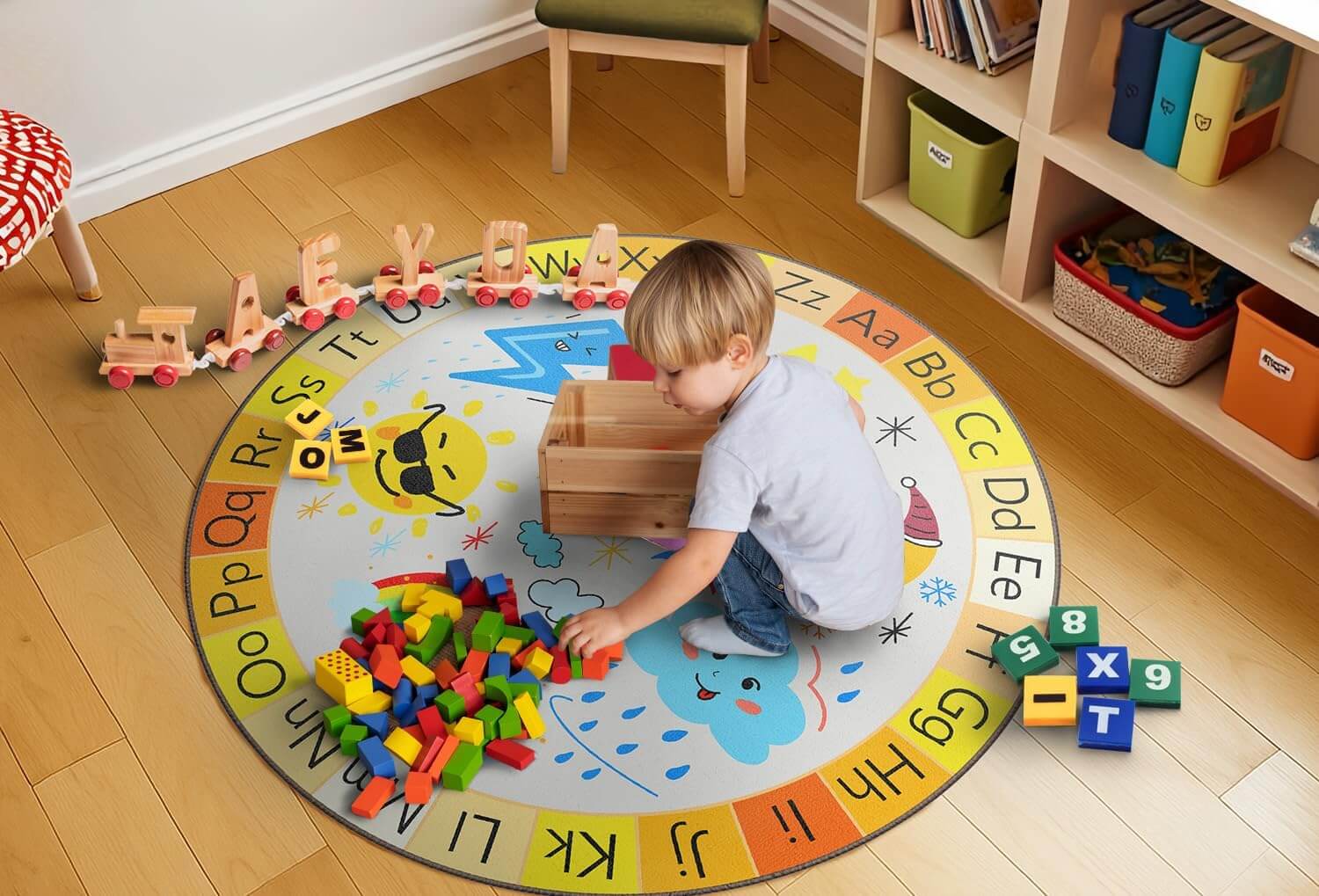Today's educational approaches demand more from our classrooms than ever before. Gone are the days of rigid rows of desks facing a single focal point.
Modern pedagogy emphasizes student-centered learning, collaboration, and flexibility—requiring physical spaces that can quickly adapt to different teaching methods and learning activities throughout the school day.
At the foundation of these adaptable spaces lies a powerful design element: the modern classroom rug.
Beyond mere floor covering, strategically selected and positioned carpeting can transform standard classrooms into dynamic, multifunctional learning environments that support diverse educational approaches while enhancing comfort, safety, and engagement.
Zone Creation with Carpet: Defining Spaces Without Walls
The cornerstone of multifunctional classroom design is the creation of distinct learning zones that can operate simultaneously or transform as needed.
Carpet offers an ideal way to create these zones without permanent barriers.
How Carpet Defines Functional Areas
- Color demarcation: Using colorful classroom rugs or different colored tiles can naturally separate reading corners from collaboration spaces.
- Pattern transitions: Changes in pattern can signal movement from instruction areas to independent work zones
- Texture variation: Subtle shifts in texture, or the use of calming pastel classroom rugs, can help students, especially those with sensory sensitivities, identify different functional areas.
According to educational design experts, these visual and tactile boundaries help students understand expectations for different types of activities without explicit instruction each time.
A study on classroom environments found that students as young as four can recognize and respond appropriately to these subtle environmental cues, reducing transition time and behavioral disruptions.
Supporting Different Learning Styles: Carpet-Based Activity Areas
Effective multifunctional classrooms accommodate various learning modalities, and carpet plays a crucial role in creating spaces that support these different approaches.
Reading and Reflection Zones
Plush, comfortable carpeting, like a dedicated reading rug, creates an inviting nook where students can engage with texts individually or in small groups.
These softer surfaces:
- Provide comfortable seating options beyond traditional chairs
- Create acoustically separated spaces for quiet concentration
- Signal "quiet zone" expectations through visual and tactile differentiation
Collaborative Learning Areas
Strategic carpet placement can define collaboration zones where students can work together without disrupting others:
- Circular carpet insets naturally encourage students to gather in discussion groups
- Patterned carpets with geometric shapes can guide desk arrangement for optimal group work
- Border elements in carpet design help contain collaborative energy within designated spaces
Presentation and Performance Spaces
Designated carpeted areas for student presentations or performances help develop confidence and communication skills:
- Rectangular carpet sections serve as natural "stages" for presentations
- Acoustic properties reduce echo and improve audibility
- Defined boundaries help manage audience placement and attention
Facilitating Quick Transitions: The Role of Carpet in Adaptable Spaces
One of the greatest challenges in multifunctional classroom design is enabling smooth transitions between different teaching modes and activities. Flexible classroom research demonstrates that effective transitions maximize instructional time and reduce behavior management issues.
How Strategic Carpeting Supports Fast Transitions
- Clear visual cues: When students can see distinct carpet-defined areas, they understand where to move for the next activity
- Noise reduction during movement: Carpet's sound-absorbing properties minimize disruption during transitions
- Embedded directional elements: Carpet patterns with directional cues can guide traffic flow between activities
- Activity-specific carpet designs: Purpose-built classroom seating rugs can eliminate setup time, with many designs featuring marked positions for circle time.
Teachers report that well-designed carpet zoning can reduce transition time by up to 5 minutes per change—potentially reclaiming 20-30 minutes of instructional time daily in elementary classrooms.
Acoustic Benefits in Flexible Spaces: Managing Sound in Multi-Activity Rooms
When different activities occur simultaneously in one classroom, sound management becomes critical. Carpet's acoustic properties make it an essential element in controlling sound transmission between zones.
Sound Management Through Strategic Carpet Use
- Absorption properties: Carpet with appropriate padding can absorb up to 70% more sound than hard flooring
- Sound transmission boundaries: Transitions between carpet types can reduce sound travel between activity zones
- Echo reduction: Carpet's soft surface minimizes echo, improving comprehension during small group instruction
- Background noise diminishment: Overall noise level reduction helps students maintain focus in flexible environments
According to acoustic research in educational settings, students in classrooms with proper sound management demonstrate better comprehension and information retention compared to those in acoustically challenging environments.
Visual Organization Through Carpet Design: Cognitive Benefits
Beyond physical organization, carpet design contributes to the cognitive organization of classroom activities.
Visual cues embedded in flooring help students develop executive functioning skills related to organization and time management.
Carpet Elements That Enhance Cognitive Organization
- Color coding: Different colored zones can correspond to different subject areas or activity types
- Pattern complexity: Simpler patterns for focus areas, more complex patterns for creative zones
- Directional indicators: Subtle directional elements can guide workflow processes
- Visual schedules: Some educational carpets incorporate timeline or schedule elements that help students understand activity progression
Research from educational psychology studies suggests that these environmental cues help students internalize organizational systems, gradually developing independent executive functioning skills.
Practical Implementation Tips: Making Carpet Work in Your Classroom
Transforming classroom design with strategic carpet choices doesn't necessarily require complete renovation. Consider these practical approaches:
For Existing Classrooms
- Area rugs: Use large classroom rugs to define primary activity zones with a single, removable piece.
- Carpet tiles: Replace portions of existing flooring to create zones
- Border elements: Use carpet tape or transition strips to visually separate spaces
- Furniture placement: Enhance carpet-defined zones with strategic furniture arrangements
For New Construction or Major Renovations
- Embedded floor patterns: Design carpet installations with permanent zone demarcation
- Modular systems: Implement carpet tile systems that allow reconfiguration as needs change
- Level changes: Slight level changes with different carpet types can enhance zone definition
- Integrated technology: Consider carpet systems that accommodate under-floor wiring for technology-rich zones
Maintenance Considerations
- Zone-specific cleaning: High-traffic collaborative areas may need more frequent maintenance
- Modular replacement: Select systems allowing replacement of sections rather than entire floors
- Stain resistance: Choose higher stain resistance for areas where art or science activities occur
- Antimicrobial properties: Consider these features for carpet in early childhood environments
Conclusion
As education continues to evolve toward more student-centered, varied instructional approaches, the physical classroom environment must keep pace.
Carpet, when thoughtfully selected and implemented, becomes far more than floor covering—it transforms into a fundamental design element that supports pedagogical flexibility while enhancing comfort, safety, and engagement.
By leveraging carpet's unique properties to create distinct zones, support various learning styles, facilitate transitions, manage acoustics, and provide visual organization, educators can create truly multifunctional spaces that adapt to teaching needs rather than limiting instructional possibilities.
Whether working with an existing classroom or designing a new educational space, consider carpet as not just a practical necessity but a powerful tool in creating learning environments that support the full spectrum of modern educational practices.




Leave a comment
This site is protected by hCaptcha and the hCaptcha Privacy Policy and Terms of Service apply.